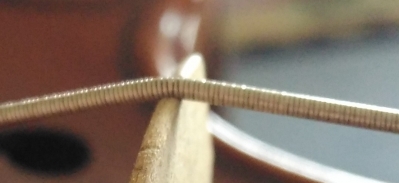Welcome to our forum. A Message To Our New and Prospective Members . Check out our Forum Rules. Lets keep this forum an enjoyable place to visit.
Currently working on errors from the latest (SimplePress) forum update. Many issues have been resoled and others are being worked on. Thank you for your patience.
 Topic RSS
Topic RSS



 (1 votes)
(1 votes) Regulars
 Offline
Offline





Yes, that's an interesting point. Some tune with the pegs: I have 4 fine tuners. But in fact the E string is almost the only one that ever needs tuning. The bottom three stay in tune with each other and I can't remember when I last tuned them. last orchestra practice, I guess!
Andrew
Verified human - the ignominy!











AndrewH said
From the location of the fraying (mostly on the pegbox side of the nut) it looks like there has been a lot of movement back and forth across the nut. Strings don't wear that far on the pegbox side of the nut from regular playing, only from tuning with the pegs. And most likely there is either a sharp edge somewhere or not enough lubrication. I only have one fine tuner, so I tune three of my four strings only with the pegs, and my strings don't wear out nearly as fast.
Yeah, good point @AndrewH I have to say on the 5 fiddles I play between, and I play a lot, I've never had a string behave like that - and it could most likely have just a tiny, REALLY tiny, little-bit-sharper-or-not-quite-so-rounded/softened-off edge at the nut, or possibly due to - yes - "something didn't sound quite right (for whatever reason) to the player" and the string has been repeatedly re-seated - landing the spiral binding on a marginally different location on the nut each time, and once the spiral-binding starts to open up, it's a one way street to damage and ultimate destruction.... LOL...
I also had this happen on one of my guitars years ago - I think it was the G if I recall - anyway - it happened relatively shortly following a string change (because the originally-fitted string had behaved exactly what the OP violin picture shows...) After two new strings (and I was very much unaware of what would cause it initially, being new to the instrument way back then) - yep - I had a very close look at the pressure-point on the nut. Concerning the guitar issue - to be honest - despite intense inspection, no, I could not actually see anything untoward - but - I filed it down anyway (very, very gently) with a miniature "jewellers file" and rounded it slightly towards the pegbox - and it (and regular normal string replacements over time) - have never broken or opened-up on the winding since- and that is now close to 50 years later... LOL
I have an interesting image of an octave-violin-G-string (fully tensioned) passing over the bridge - the opening-up of the winding on this heavier string is clearly evident - a similar issue (to a lesser extent) can occur at the nut anyway.... it is normal to *some* degree athe the pressure-point, and has to be expected - although a properly carved bridge and shaped nut would generally not be expected from a good luthier or home-diy'er to be like that - but - it CAN BE virtually imperceptible... so yes, IMO, indeed on rare occasions, minor, really minor, almost imperceptible issues at the edges can end up creating an issue... very rarely, I'm sure, but, we are not perfect....
I seriously recommend not copying my mistakes. D'oh -
Please make your own, different mistakes, and help us all learn :-)
Member
 Offline
OfflineHello bunify
I know this reply might be a bit late in the game assuming that your problem with the peg is rectified I can only add a suggestion pertaining to the projection of your instrument if your still overwhelmed with the sound.
I had similar issues twelve years ago I guess it was and I had a cheap instrument that I was highly aggravated with it really had a bad whistle to its tone projection having looked back on it and putting time into investigating things far better than I did back then I learned there were a couple issues that fell on me I believe I had the bridge on this violin set too far forward.
After figuring out the proper way to set a bridge I also figured out that strings play a big role,instruments react differently to different strings this can be a pain to figure out and can be costly as well.
If I were to take a shot in the dark though I would suggest D'addario Pro-Art'e strings to tone your violin down these are a significantly darker synthetic core strings.
In fact I've been using the D'Addario ascent'e strings on my third acoustic violin and like them better than the Thomastik Dominant strings,the E always sounded off on the Dominants as apposed to the Ascent'es but to each his own.
I also like the Hill peg compound which from all I've read is better than peg drops as most people say the drops cause their pegs to creek and pop.
1 Guest(s)


 Log In
Log In Register
Register












